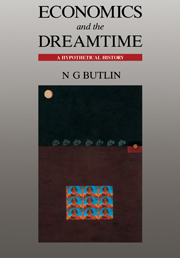Book contents
- Frontmatter
- Contents
- Preface
- Acknowledgements
- Figures
- Maps
- Tables
- Introduction
- Part I The palaeoeconomic history of Aboriginal migration
- Part II Development, structure and function of Aboriginal economy
- Part III Disease, economics and demography
- Part IV The establishment of a bridgehead economy: 1788–1810
- Part V The takeover process: 1788–1850
- 19 Introduction
- 20 British development in the long run
- 21 The hunter gatherers of empire
- 22 British, American and Macassan presence in the takeover
- 23 The major players
- 24 Aborigines and British law
- 25 The economics of takeover
- 26 The composition and demographic impact of disease
- 27 The interaction of disease with resistance, integration and submission
- 28 Conclusions
- Bibliography
- Appendix 1 Preliminary model/checklist of Aboriginal migration to Australia
- Appendix 2 NOAA depth contour maps
- Index
27 - The interaction of disease with resistance, integration and submission
Published online by Cambridge University Press: 06 July 2010
- Frontmatter
- Contents
- Preface
- Acknowledgements
- Figures
- Maps
- Tables
- Introduction
- Part I The palaeoeconomic history of Aboriginal migration
- Part II Development, structure and function of Aboriginal economy
- Part III Disease, economics and demography
- Part IV The establishment of a bridgehead economy: 1788–1810
- Part V The takeover process: 1788–1850
- 19 Introduction
- 20 British development in the long run
- 21 The hunter gatherers of empire
- 22 British, American and Macassan presence in the takeover
- 23 The major players
- 24 Aborigines and British law
- 25 The economics of takeover
- 26 The composition and demographic impact of disease
- 27 The interaction of disease with resistance, integration and submission
- 28 Conclusions
- Bibliography
- Appendix 1 Preliminary model/checklist of Aboriginal migration to Australia
- Appendix 2 NOAA depth contour maps
- Index
Summary
It is convenient not only to begin with but also to concentrate on the early experience at Botany Bay. When the smallpox epidemic occurred there in 1789, Phillip for reasons that are obscure delayed until the following year any report to Whitehall. He wrote two despatches, in each case with a brief reference to the epidemic submerged in a lengthy outline of the state and problems of the settlement. Phillip reached three conclusions: (1) about half the local Aboriginal population died; (2) the disease must have spread far inland and along the coast; (3) less military force would be necessary for protecting the settlement than he had anticipated. In the event, he was wrong on the last point. In the meantime, Aborigines had been infected with venereal disease. As Collins (1798) observed, ‘I fear our people have to answer for that’.
Given the relatively tight geographical constraint on the first settlement within the Cumberland Plain for the first 20 odd years, we have the chance to consider, in microcosm, many of the interrelations between diseases and the takeover process in general. Some important lessons are to be learned. Before the smallpox epidemic, there was spasmodic and isolated violence by Aborigines, particularly towards convicts and their guards sent to isolated job locations. From late 1788, Aborigines appear to have broken contact with the British settlers, except for two captured for purposes of communication.
- Type
- Chapter
- Information
- Economics and the DreamtimeA Hypothetical History, pp. 221 - 226Publisher: Cambridge University PressPrint publication year: 1993



